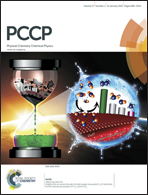Reverse hydrotropy by complex formation†
Abstract
Self-aggregation of three di-N-alkylated diaza-18-crown-6 ethers (ACEs) was studied in non-polar solvents. The three ACEs differed by the length of the alkyl chain: n-decyl (ACE-10), n-hexadecyl (ACE-16) and n-tetracosane (ACE-24). From the previously reported interfacial tension isotherms, the formation of reverse micelles was expected above ACE concentrations of ∼10−3 M. However, the water content analysis in conjunction with Dynamic Light Scattering (DLS), Fluorescence Correlation Spectroscopy (FCS) and 1H NMR Diffusion Ordered Spectroscopy (DOSY) do not provide any clear proof of the existence of aggregates. Only the Small Angle Neutron Scattering (SANS) of concentrated toluene ACE solutions reveals the existence of small reverse micelles (probably ACE dimers forming small cages hosting 1–2 water molecules). On the other hand, spectrophotometric and fluorescence dye dissolution studies using eosin Y, tropaeolin OO and methyl orange suggest that ACEs can dissolve these dyes without requiring the formation of aggregates. This discrepancy was interpreted assuming the dye–ACE complexation as the driving force for dye solubilisation, providing a possible mechanism of reverse hydrotropy (“lipotropy”) in non-polar solvents. This example shows that special care should be taken when dye solubilisation is used to probe self-aggregation of an amphiphile in non-polar solvents. The amphiphile–dye complex formation might be responsible for false positive results and the aggregate formation should always be confirmed with other methods.


 Please wait while we load your content...
Please wait while we load your content...